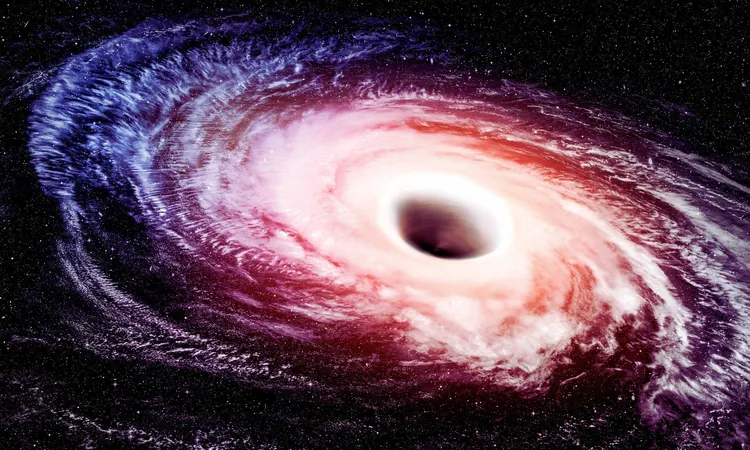
Astronomers Discover a Quiet Giant: Evidence of a Massive Black Hole from the Early Universe
2025-01-05
Author: Jia
A Groundbreaking Discovery
A groundbreaking discovery has caught the attention of astronomers: evidence of a colossal black hole that formed in the infant universe, later entering a prolonged phase of quietude while the surrounding cosmos bustled with activity. This enigmatic black hole presents fresh insights into our understanding of cosmic evolution and the growth of galaxies.
Research conducted by a team at the University of Cambridge has revealed this massive black hole, which deviates from the typical narrative of loud and ravenous black holes that consume matter at remarkable rates. Instead, this particular black hole showcases a rare behavior—existing in a subdued state despite the dynamic environment of the early universe.
Scientists argue that its existence raises the tantalizing possibility of numerous similar black holes lying dormant amidst brilliant galaxies. Roberto Maiolino from the University of Cambridge suggests that these quiet giants could be nestled in the cosmic shadows, serenely coexisting with more active celestial neighbors.
An Unexpected Lifecycle
What makes this discovery truly astonishing is the timing of the black hole's growth. Observations indicate that it accrued mass much quicker than previously anticipated, suggesting a brief but intense feeding frenzy followed by a lengthy dormancy. Although currently faint, researchers discovered remnants of its once-vibrant activity, hinting that sporadic influxes of matter contributed to its rapid growth while largely going unnoticed.
Surprisingly, the galaxy housing this black hole appears deficient in new star formation during the black hole’s early active period. This raises intriguing questions about the black hole's influence on its environment; it is speculated that the energy released may have disrupted the gas necessary for star formation, effectively stifling the growth of new stars.
Changing Perspectives in Black Hole Research
The significance of this discovery has prompted discussions among astrophysicists about revising existing models of early black holes. Traditionally, it was believed that black holes formed in the universe's infancy were bright and easily noticeable. This latest finding challenges that notion, proposing that many giant black holes could remain hidden for epochs, slipping under the radar of observational astronomy.
Research teams employed sophisticated spectral analyses to isolate the emissions from starlight, enabling them to estimate the black hole’s mass and its effects on its surroundings. The dim galaxy suggests a post-natal environment that didn’t support extensive star formation, which raises further questions about the interplay between black holes and galaxies.
Implications for Cosmic Understanding
The implications of such findings are profound. By probing these sleepy black holes, astronomers can unlock secrets about the history of the universe—specifically, how massive structures emerged from dense gas clouds and influenced star formation. Moreover, the discovery of these dormant titans could usher in a new era of exploration in cosmology, potentially revealing even more hidden giants scattered across the universe.
Future research endeavors will leverage enhanced observational tools and simulations to identify more of these elusive black holes. The goal is to build a comprehensive map of dormant black holes, which could ultimately reshape our understanding of cosmic evolution and the conditions favorable to life.
The enduring mystery surrounding black holes, especially those that reside in silence, challenges conventional narratives and illuminates the complexity of the universe. As researchers diligently seek out these elusive cosmic giants, they warn fellow astronomers and enthusiasts alike of the intricate layers of our universe yet to be uncovered, hinting at the vast possibility that not all black holes are the gaping, luminous monsters of popular imagination.
This profound discovery emphasizes the need for continued exploration and innovation within astrophysics. The quest for understanding black holes not only sheds light on the universe’s past but also paves the way for advancements in technology and data analysis methodologies that could benefit other scientific domains.
So, buckle up, space enthusiasts! The universe is full of secrets, and this could just be the beginning of uncovering a new chapter in cosmic history. Stay tuned for further developments as we delve deeper into the silent giants that roam the cosmos.

 Brasil (PT)
Brasil (PT)
 Canada (EN)
Canada (EN)
 Chile (ES)
Chile (ES)
 Česko (CS)
Česko (CS)
 대한민국 (KO)
대한민국 (KO)
 España (ES)
España (ES)
 France (FR)
France (FR)
 Hong Kong (EN)
Hong Kong (EN)
 Italia (IT)
Italia (IT)
 日本 (JA)
日本 (JA)
 Magyarország (HU)
Magyarország (HU)
 Norge (NO)
Norge (NO)
 Polska (PL)
Polska (PL)
 Schweiz (DE)
Schweiz (DE)
 Singapore (EN)
Singapore (EN)
 Sverige (SV)
Sverige (SV)
 Suomi (FI)
Suomi (FI)
 Türkiye (TR)
Türkiye (TR)
 الإمارات العربية المتحدة (AR)
الإمارات العربية المتحدة (AR)